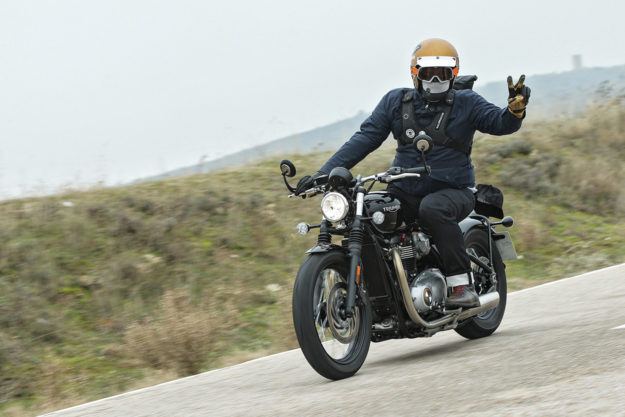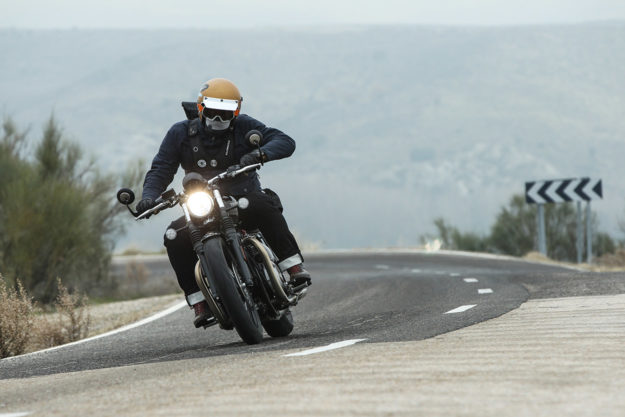
Ride So it looks cool and feels cool—but how does it ride? Damn well, as it turns out. Triumph’s sweepers led us out of Madrid for some urban and highway riding, and took us through twisty mountain roads out in the Spanish countryside. Winter temperatures and all.
I was smiling the second I fired it up and heard the exhaust’s deep rumble. There’s quality over volume; rather than being loud and tinny, the twin, slash-cut cans pump out a deep, throaty hum.
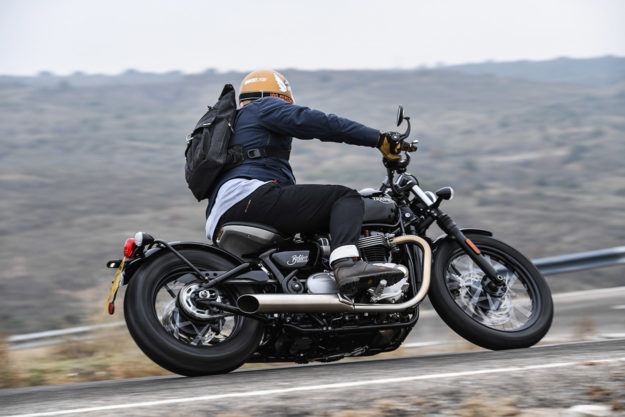
The fueling, transmission and torque-assisted clutch are buttery smooth—almost to a fault. I say almost, because Triumph have managed to make the Bobber smooth without making it too vanilla—mostly thanks to the 270 degree crank, and that revised tune.
Putting most of the oompf down low was an inspired decision. Pulling away is a gas, and rolling on the throttle out of a corner is pure joy as the bike surges forward, bolstered by the drone of the exhaust.
The ABS and traction control are unobtrusive, but I didn’t notice a massive difference between the ‘Rain’ and ‘Road’ modes.

There’s no adjustment on either the front or rear suspension—and only three inches of rear travel—but it copes just fine. Daily annoyances like speed humps and potholes are no hassle. The only time I managed to make the rear bottom out was when I hopped the bike off a curb with all of my weight.
The one thing the Bobber doesn’t have, though, is ample ground clearance. You can toss it around a lot harder than you’d imagine—but then your foot pegs (or the side of your boot) will hit the asphalt.
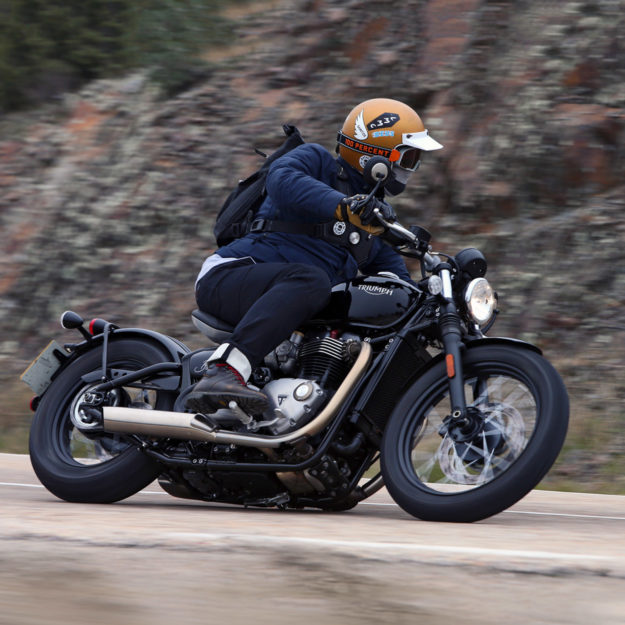
That’s par for the course, really. You wouldn’t pick a bobber for its ride height any more than you’d pick a café racer for its long distance comfort. Except this bobber can corner hard—it’s just going to make a noise and send sparks flying while doing so.
Even the big difference between front and back wheel sizes doesn’t seem to hinder it. According to Triumph’s chassis engineer, the frame is all-new, so the geometry is fully optimized.
Bottom line: the Bobber rides much better than it has any business to. A little more braking power would be nice here and there (I found myself squeezing the adjustable lever hard a couple of times), but that’s all I can fault it on.
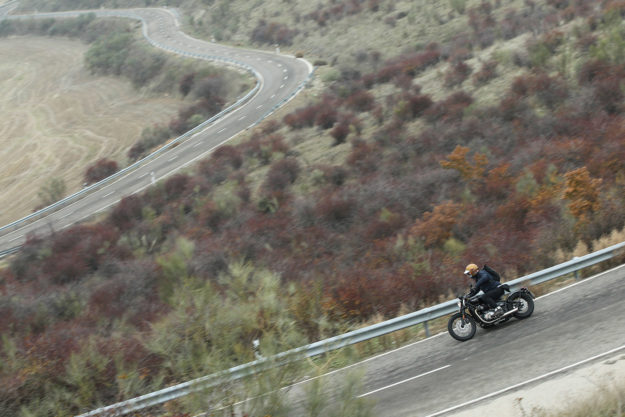
Customizing Once the riding was done, my mind immediately drifted back to how good the Bobber looks. Specifically, how Triumph have given owners room to fettle their bikes. It took less than a minute for my mind to fill up with ideas.
Triumph already have 150 aftermarket parts available—ranging from various covers in different finishes, to handlebar options, and even a full LED headlight.
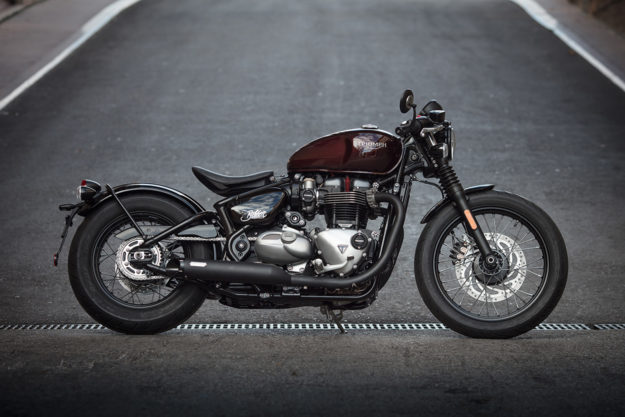
On the performance side, they’ve got a couple of Vance & Hines exhaust options, and an adjustable rear shock from Fox. You can fit heated grips (which our test bikes thankfully, had) and cruise control. And both of those accessories interface with the speedo display after installation.
They’ve got two inspiration kits too: Triumph-speak for complementary parts that can be bought as a set. There’s the ‘Old School Bobber’ featuring rather, um, radical ape hangers (below), and the ‘Quarter Mile Bobber’ with clip-ons for a drag bike aesthetic (above).
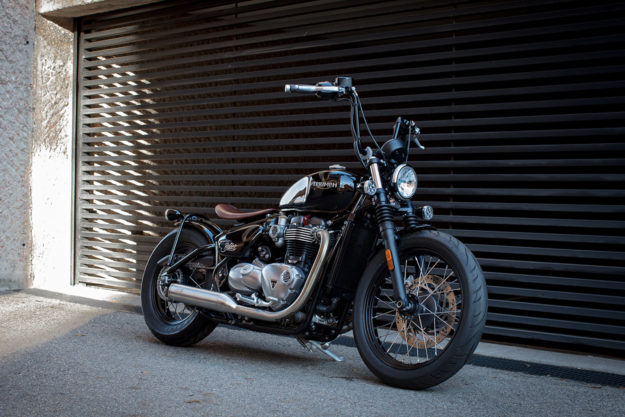
We could see ourselves customizing the Bobber with a mix of Triumph, third party and hand-made bits. Down & Out’s custom Bobber was on display too, and is a testament to how much fun can be had, and quickly. (They built their bike in less than three weeks).
Choosing colors is easier: You can get the Bobber in Morello Red, Ironstone, Jet Black, or a fetching heritage-themed Competition Green and Frozen Silver.
Who’s it for? Triumph have produced a yet another machine that feels modern but looks classic. And it’s resonating with the general public: We’re told that pre-order numbers have already exceeded those of the Thruxton R.
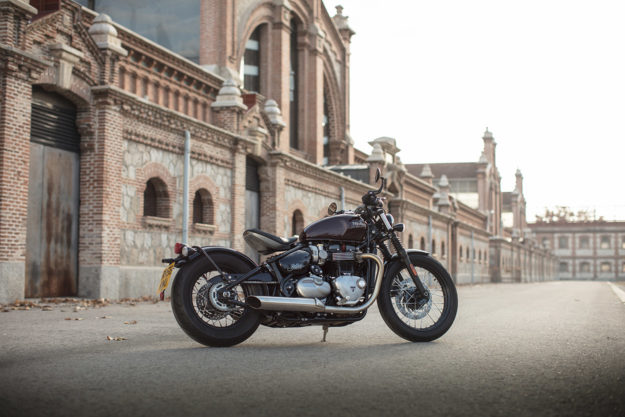
But it’s hard to pigeonhole the Bobber. In some ways, it goes head-to-head with every other modern classic on the market. In others, it’s competition for Harley’s Forty-Eight, or Yamaha’s XV950 Bolt. But we reckon the scene’s gone beyond the point where comparisons matter.
If you want to put a Bobber in your garage, USA deliveries will start in late February/early March, with pricing starting at $11,900 for the Jet Black model. That’s more than a T120, but less than a Thruxton. (It’s also about $600 more than both the Harley Forty-Eight and Indian Scout, but that feels about right.) In the UK, deliveries are scheduled for mid-February with pricing starting at £10,500.
Our conclusion? At the end of the day, don’t get drawn into over-thinking the Bobber. It’s a really cool, well-engineered and single-minded bike—and it’s a total blast to ride.
The biggest downside? I eventually had to get off.
Images courtesy of Triumph Motorcycles | Facebook | Instagram
